Management Accounting Report: Cost Analysis, Budgeting, and Systems
VerifiedAdded on 2020/11/12
|17
|4418
|127
Report
AI Summary
This report delves into the realm of management accounting, focusing on its vital role in organizational decision-making and financial strategy. It begins by defining management accounting and contrasting it with financial accounting, highlighting the different types of management accounting systems such as cost-accounting, inventory management, job-costing, and price-optimizing systems. The report then explores various management accounting reporting methods, including budgets, performance reports, and aging reports. A significant portion of the report is dedicated to cost analysis techniques, with detailed explanations and examples of absorption costing and marginal costing. Income statements are generated using both methods, demonstrating how costs are allocated and how different costing approaches impact profitability. The report provides detailed financial statements for a company, TSR Pvt. Ltd., under varying production and sales scenarios. The report also discusses the merits and demerits of budgetary control and compares the adaptation of management accounting systems in response to financial problems.
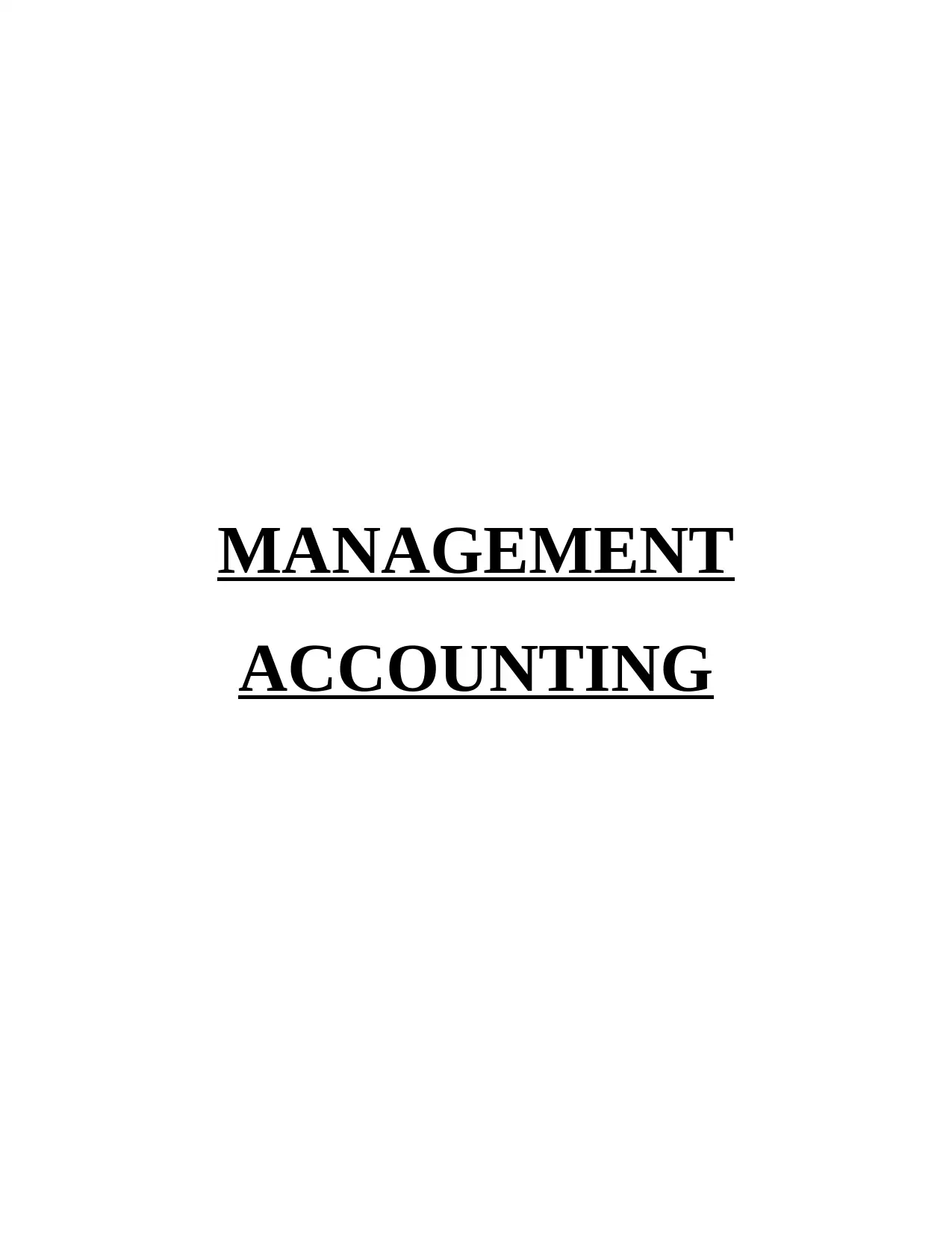
MANAGEMENT
ACCOUNTING
ACCOUNTING
Paraphrase This Document
Need a fresh take? Get an instant paraphrase of this document with our AI Paraphraser
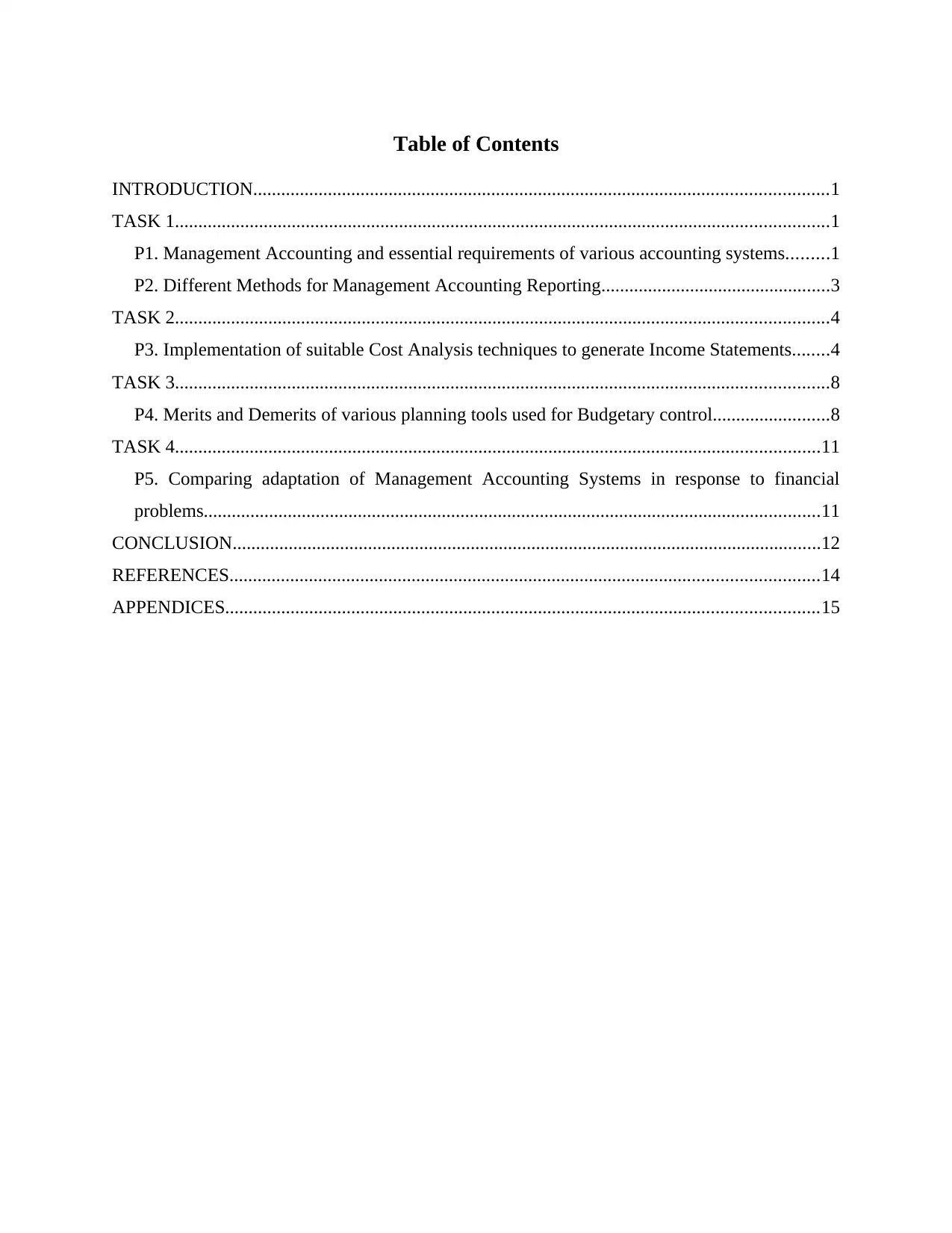
Table of Contents
INTRODUCTION...........................................................................................................................1
TASK 1............................................................................................................................................1
P1. Management Accounting and essential requirements of various accounting systems.........1
P2. Different Methods for Management Accounting Reporting.................................................3
TASK 2............................................................................................................................................4
P3. Implementation of suitable Cost Analysis techniques to generate Income Statements........4
TASK 3............................................................................................................................................8
P4. Merits and Demerits of various planning tools used for Budgetary control.........................8
TASK 4..........................................................................................................................................11
P5. Comparing adaptation of Management Accounting Systems in response to financial
problems....................................................................................................................................11
CONCLUSION..............................................................................................................................12
REFERENCES..............................................................................................................................14
APPENDICES...............................................................................................................................15
INTRODUCTION...........................................................................................................................1
TASK 1............................................................................................................................................1
P1. Management Accounting and essential requirements of various accounting systems.........1
P2. Different Methods for Management Accounting Reporting.................................................3
TASK 2............................................................................................................................................4
P3. Implementation of suitable Cost Analysis techniques to generate Income Statements........4
TASK 3............................................................................................................................................8
P4. Merits and Demerits of various planning tools used for Budgetary control.........................8
TASK 4..........................................................................................................................................11
P5. Comparing adaptation of Management Accounting Systems in response to financial
problems....................................................................................................................................11
CONCLUSION..............................................................................................................................12
REFERENCES..............................................................................................................................14
APPENDICES...............................................................................................................................15
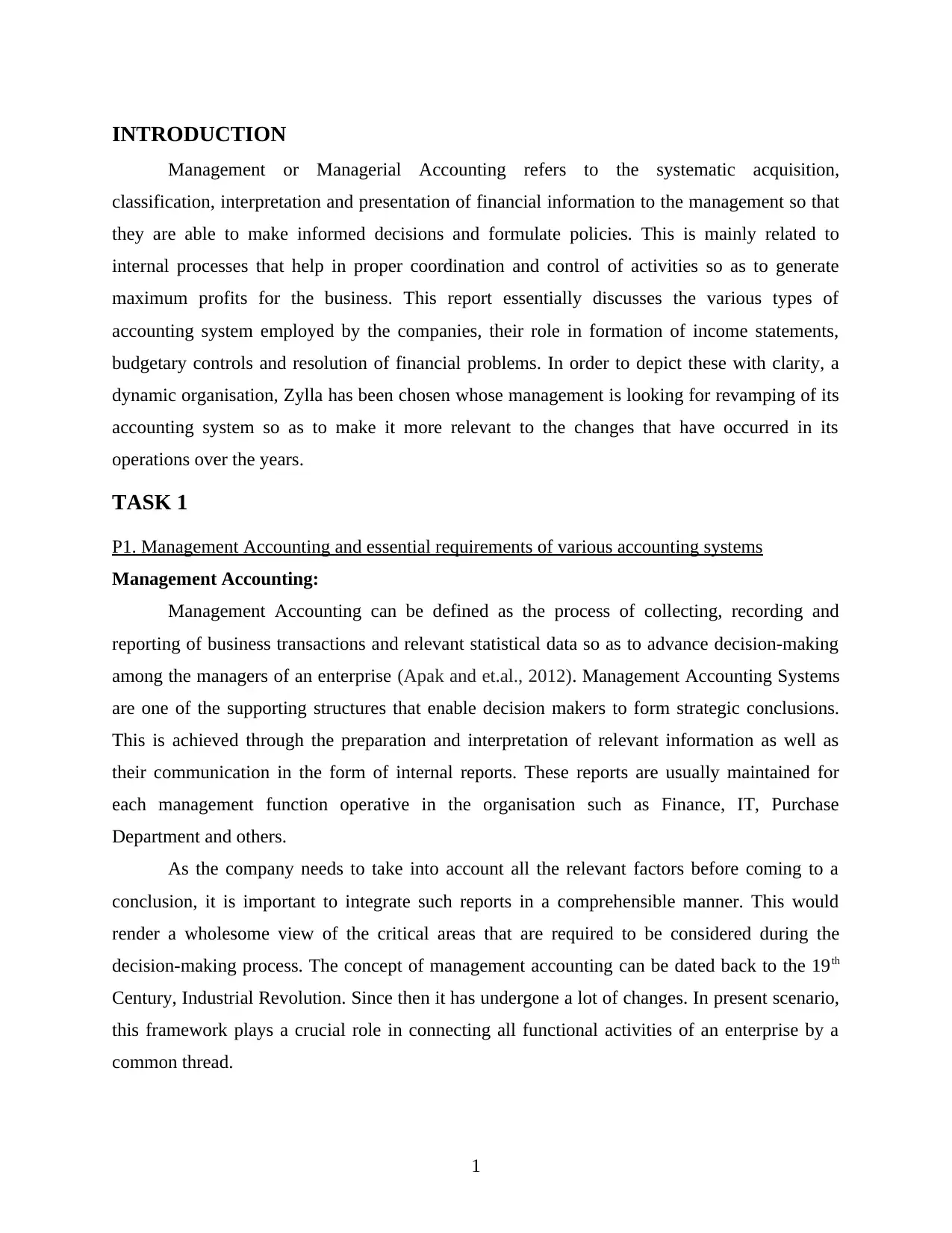
INTRODUCTION
Management or Managerial Accounting refers to the systematic acquisition,
classification, interpretation and presentation of financial information to the management so that
they are able to make informed decisions and formulate policies. This is mainly related to
internal processes that help in proper coordination and control of activities so as to generate
maximum profits for the business. This report essentially discusses the various types of
accounting system employed by the companies, their role in formation of income statements,
budgetary controls and resolution of financial problems. In order to depict these with clarity, a
dynamic organisation, Zylla has been chosen whose management is looking for revamping of its
accounting system so as to make it more relevant to the changes that have occurred in its
operations over the years.
TASK 1
P1. Management Accounting and essential requirements of various accounting systems
Management Accounting:
Management Accounting can be defined as the process of collecting, recording and
reporting of business transactions and relevant statistical data so as to advance decision-making
among the managers of an enterprise (Apak and et.al., 2012). Management Accounting Systems
are one of the supporting structures that enable decision makers to form strategic conclusions.
This is achieved through the preparation and interpretation of relevant information as well as
their communication in the form of internal reports. These reports are usually maintained for
each management function operative in the organisation such as Finance, IT, Purchase
Department and others.
As the company needs to take into account all the relevant factors before coming to a
conclusion, it is important to integrate such reports in a comprehensible manner. This would
render a wholesome view of the critical areas that are required to be considered during the
decision-making process. The concept of management accounting can be dated back to the 19th
Century, Industrial Revolution. Since then it has undergone a lot of changes. In present scenario,
this framework plays a crucial role in connecting all functional activities of an enterprise by a
common thread.
1
Management or Managerial Accounting refers to the systematic acquisition,
classification, interpretation and presentation of financial information to the management so that
they are able to make informed decisions and formulate policies. This is mainly related to
internal processes that help in proper coordination and control of activities so as to generate
maximum profits for the business. This report essentially discusses the various types of
accounting system employed by the companies, their role in formation of income statements,
budgetary controls and resolution of financial problems. In order to depict these with clarity, a
dynamic organisation, Zylla has been chosen whose management is looking for revamping of its
accounting system so as to make it more relevant to the changes that have occurred in its
operations over the years.
TASK 1
P1. Management Accounting and essential requirements of various accounting systems
Management Accounting:
Management Accounting can be defined as the process of collecting, recording and
reporting of business transactions and relevant statistical data so as to advance decision-making
among the managers of an enterprise (Apak and et.al., 2012). Management Accounting Systems
are one of the supporting structures that enable decision makers to form strategic conclusions.
This is achieved through the preparation and interpretation of relevant information as well as
their communication in the form of internal reports. These reports are usually maintained for
each management function operative in the organisation such as Finance, IT, Purchase
Department and others.
As the company needs to take into account all the relevant factors before coming to a
conclusion, it is important to integrate such reports in a comprehensible manner. This would
render a wholesome view of the critical areas that are required to be considered during the
decision-making process. The concept of management accounting can be dated back to the 19th
Century, Industrial Revolution. Since then it has undergone a lot of changes. In present scenario,
this framework plays a crucial role in connecting all functional activities of an enterprise by a
common thread.
1
⊘ This is a preview!⊘
Do you want full access?
Subscribe today to unlock all pages.

Trusted by 1+ million students worldwide
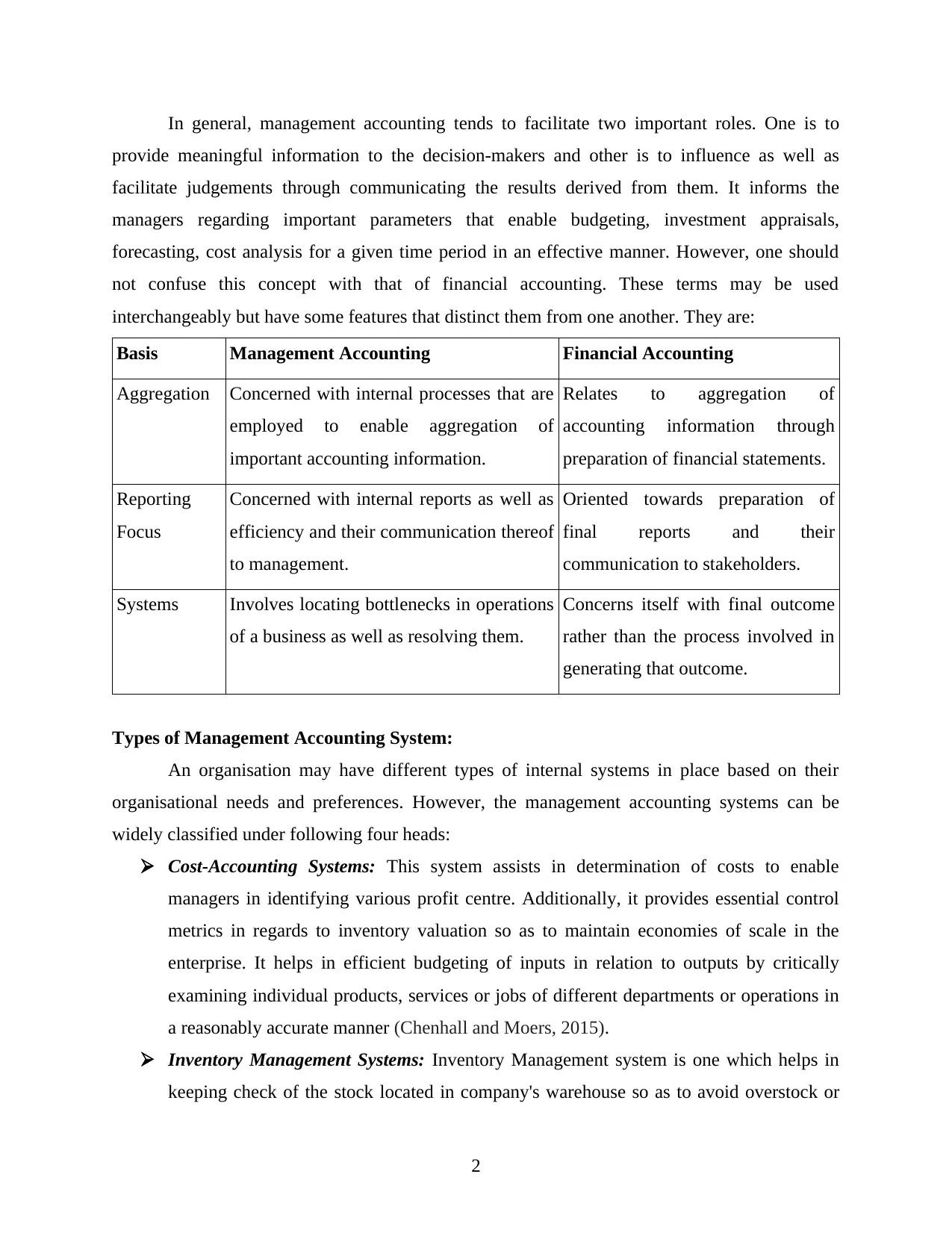
In general, management accounting tends to facilitate two important roles. One is to
provide meaningful information to the decision-makers and other is to influence as well as
facilitate judgements through communicating the results derived from them. It informs the
managers regarding important parameters that enable budgeting, investment appraisals,
forecasting, cost analysis for a given time period in an effective manner. However, one should
not confuse this concept with that of financial accounting. These terms may be used
interchangeably but have some features that distinct them from one another. They are:
Basis Management Accounting Financial Accounting
Aggregation Concerned with internal processes that are
employed to enable aggregation of
important accounting information.
Relates to aggregation of
accounting information through
preparation of financial statements.
Reporting
Focus
Concerned with internal reports as well as
efficiency and their communication thereof
to management.
Oriented towards preparation of
final reports and their
communication to stakeholders.
Systems Involves locating bottlenecks in operations
of a business as well as resolving them.
Concerns itself with final outcome
rather than the process involved in
generating that outcome.
Types of Management Accounting System:
An organisation may have different types of internal systems in place based on their
organisational needs and preferences. However, the management accounting systems can be
widely classified under following four heads:
Cost-Accounting Systems: This system assists in determination of costs to enable
managers in identifying various profit centre. Additionally, it provides essential control
metrics in regards to inventory valuation so as to maintain economies of scale in the
enterprise. It helps in efficient budgeting of inputs in relation to outputs by critically
examining individual products, services or jobs of different departments or operations in
a reasonably accurate manner (Chenhall and Moers, 2015).
Inventory Management Systems: Inventory Management system is one which helps in
keeping check of the stock located in company's warehouse so as to avoid overstock or
2
provide meaningful information to the decision-makers and other is to influence as well as
facilitate judgements through communicating the results derived from them. It informs the
managers regarding important parameters that enable budgeting, investment appraisals,
forecasting, cost analysis for a given time period in an effective manner. However, one should
not confuse this concept with that of financial accounting. These terms may be used
interchangeably but have some features that distinct them from one another. They are:
Basis Management Accounting Financial Accounting
Aggregation Concerned with internal processes that are
employed to enable aggregation of
important accounting information.
Relates to aggregation of
accounting information through
preparation of financial statements.
Reporting
Focus
Concerned with internal reports as well as
efficiency and their communication thereof
to management.
Oriented towards preparation of
final reports and their
communication to stakeholders.
Systems Involves locating bottlenecks in operations
of a business as well as resolving them.
Concerns itself with final outcome
rather than the process involved in
generating that outcome.
Types of Management Accounting System:
An organisation may have different types of internal systems in place based on their
organisational needs and preferences. However, the management accounting systems can be
widely classified under following four heads:
Cost-Accounting Systems: This system assists in determination of costs to enable
managers in identifying various profit centre. Additionally, it provides essential control
metrics in regards to inventory valuation so as to maintain economies of scale in the
enterprise. It helps in efficient budgeting of inputs in relation to outputs by critically
examining individual products, services or jobs of different departments or operations in
a reasonably accurate manner (Chenhall and Moers, 2015).
Inventory Management Systems: Inventory Management system is one which helps in
keeping check of the stock located in company's warehouse so as to avoid overstock or
2
Paraphrase This Document
Need a fresh take? Get an instant paraphrase of this document with our AI Paraphraser
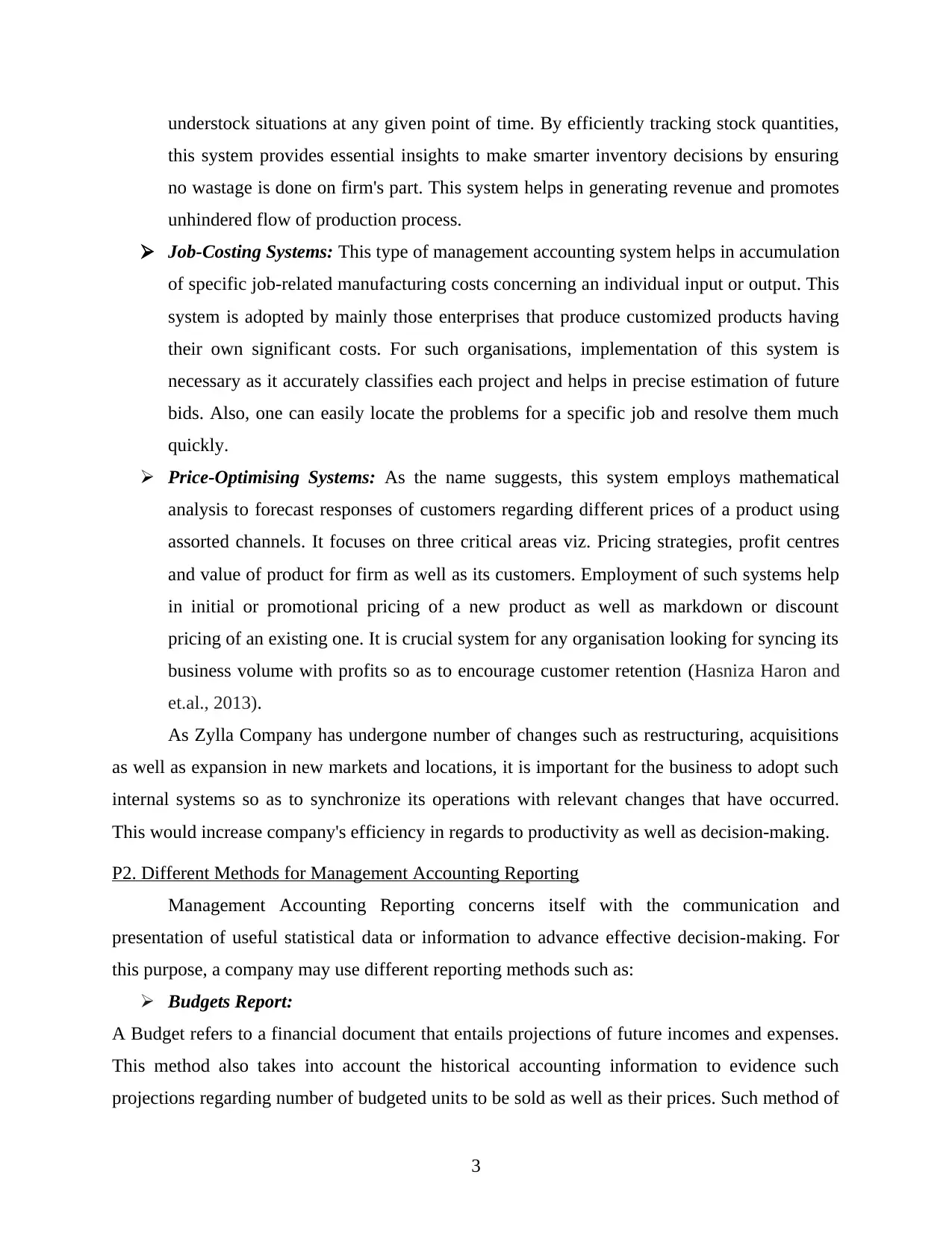
understock situations at any given point of time. By efficiently tracking stock quantities,
this system provides essential insights to make smarter inventory decisions by ensuring
no wastage is done on firm's part. This system helps in generating revenue and promotes
unhindered flow of production process.
Job-Costing Systems: This type of management accounting system helps in accumulation
of specific job-related manufacturing costs concerning an individual input or output. This
system is adopted by mainly those enterprises that produce customized products having
their own significant costs. For such organisations, implementation of this system is
necessary as it accurately classifies each project and helps in precise estimation of future
bids. Also, one can easily locate the problems for a specific job and resolve them much
quickly.
Price-Optimising Systems: As the name suggests, this system employs mathematical
analysis to forecast responses of customers regarding different prices of a product using
assorted channels. It focuses on three critical areas viz. Pricing strategies, profit centres
and value of product for firm as well as its customers. Employment of such systems help
in initial or promotional pricing of a new product as well as markdown or discount
pricing of an existing one. It is crucial system for any organisation looking for syncing its
business volume with profits so as to encourage customer retention (Hasniza Haron and
et.al., 2013).
As Zylla Company has undergone number of changes such as restructuring, acquisitions
as well as expansion in new markets and locations, it is important for the business to adopt such
internal systems so as to synchronize its operations with relevant changes that have occurred.
This would increase company's efficiency in regards to productivity as well as decision-making.
P2. Different Methods for Management Accounting Reporting
Management Accounting Reporting concerns itself with the communication and
presentation of useful statistical data or information to advance effective decision-making. For
this purpose, a company may use different reporting methods such as:
Budgets Report:
A Budget refers to a financial document that entails projections of future incomes and expenses.
This method also takes into account the historical accounting information to evidence such
projections regarding number of budgeted units to be sold as well as their prices. Such method of
3
this system provides essential insights to make smarter inventory decisions by ensuring
no wastage is done on firm's part. This system helps in generating revenue and promotes
unhindered flow of production process.
Job-Costing Systems: This type of management accounting system helps in accumulation
of specific job-related manufacturing costs concerning an individual input or output. This
system is adopted by mainly those enterprises that produce customized products having
their own significant costs. For such organisations, implementation of this system is
necessary as it accurately classifies each project and helps in precise estimation of future
bids. Also, one can easily locate the problems for a specific job and resolve them much
quickly.
Price-Optimising Systems: As the name suggests, this system employs mathematical
analysis to forecast responses of customers regarding different prices of a product using
assorted channels. It focuses on three critical areas viz. Pricing strategies, profit centres
and value of product for firm as well as its customers. Employment of such systems help
in initial or promotional pricing of a new product as well as markdown or discount
pricing of an existing one. It is crucial system for any organisation looking for syncing its
business volume with profits so as to encourage customer retention (Hasniza Haron and
et.al., 2013).
As Zylla Company has undergone number of changes such as restructuring, acquisitions
as well as expansion in new markets and locations, it is important for the business to adopt such
internal systems so as to synchronize its operations with relevant changes that have occurred.
This would increase company's efficiency in regards to productivity as well as decision-making.
P2. Different Methods for Management Accounting Reporting
Management Accounting Reporting concerns itself with the communication and
presentation of useful statistical data or information to advance effective decision-making. For
this purpose, a company may use different reporting methods such as:
Budgets Report:
A Budget refers to a financial document that entails projections of future incomes and expenses.
This method also takes into account the historical accounting information to evidence such
projections regarding number of budgeted units to be sold as well as their prices. Such method of
3
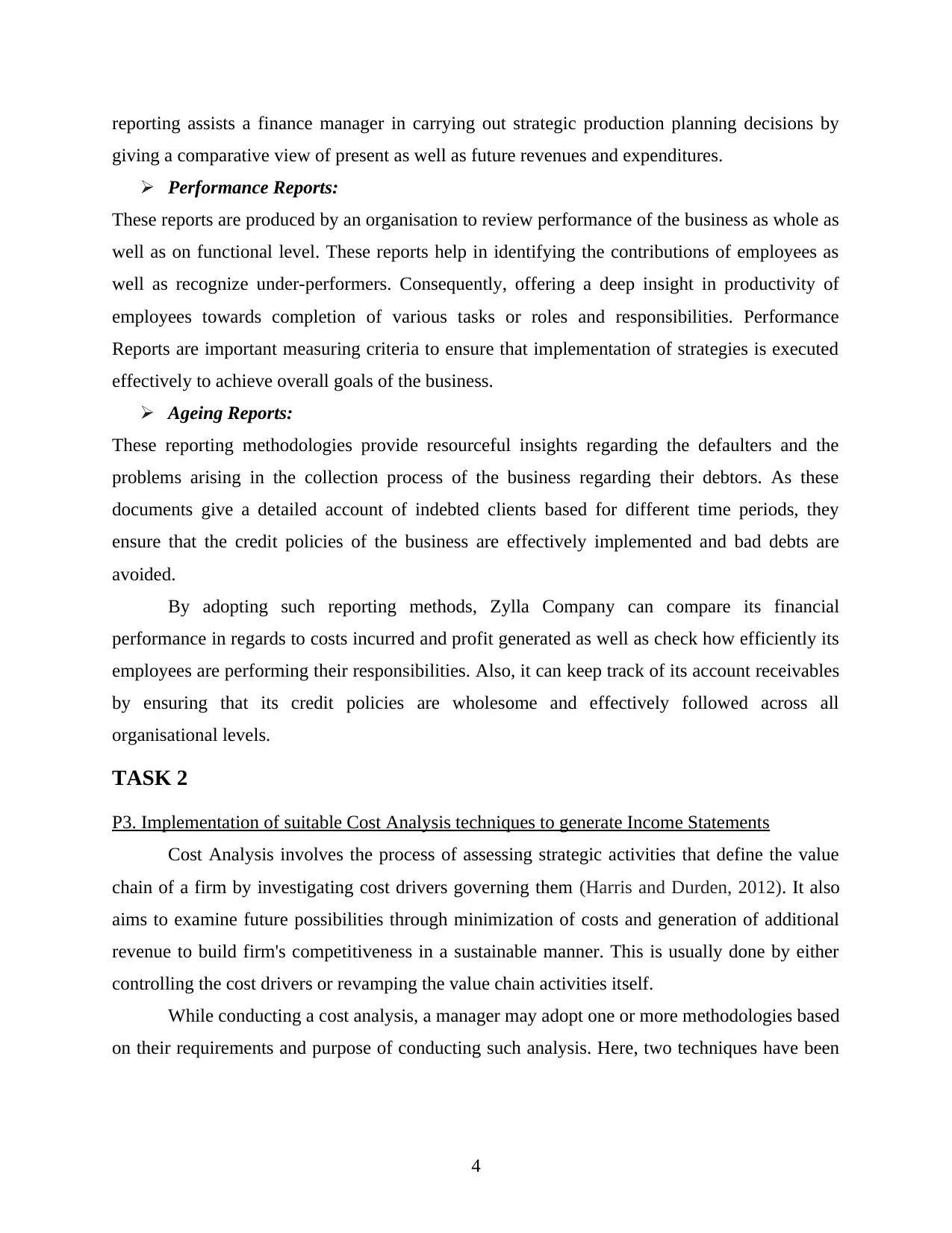
reporting assists a finance manager in carrying out strategic production planning decisions by
giving a comparative view of present as well as future revenues and expenditures.
Performance Reports:
These reports are produced by an organisation to review performance of the business as whole as
well as on functional level. These reports help in identifying the contributions of employees as
well as recognize under-performers. Consequently, offering a deep insight in productivity of
employees towards completion of various tasks or roles and responsibilities. Performance
Reports are important measuring criteria to ensure that implementation of strategies is executed
effectively to achieve overall goals of the business.
Ageing Reports:
These reporting methodologies provide resourceful insights regarding the defaulters and the
problems arising in the collection process of the business regarding their debtors. As these
documents give a detailed account of indebted clients based for different time periods, they
ensure that the credit policies of the business are effectively implemented and bad debts are
avoided.
By adopting such reporting methods, Zylla Company can compare its financial
performance in regards to costs incurred and profit generated as well as check how efficiently its
employees are performing their responsibilities. Also, it can keep track of its account receivables
by ensuring that its credit policies are wholesome and effectively followed across all
organisational levels.
TASK 2
P3. Implementation of suitable Cost Analysis techniques to generate Income Statements
Cost Analysis involves the process of assessing strategic activities that define the value
chain of a firm by investigating cost drivers governing them (Harris and Durden, 2012). It also
aims to examine future possibilities through minimization of costs and generation of additional
revenue to build firm's competitiveness in a sustainable manner. This is usually done by either
controlling the cost drivers or revamping the value chain activities itself.
While conducting a cost analysis, a manager may adopt one or more methodologies based
on their requirements and purpose of conducting such analysis. Here, two techniques have been
4
giving a comparative view of present as well as future revenues and expenditures.
Performance Reports:
These reports are produced by an organisation to review performance of the business as whole as
well as on functional level. These reports help in identifying the contributions of employees as
well as recognize under-performers. Consequently, offering a deep insight in productivity of
employees towards completion of various tasks or roles and responsibilities. Performance
Reports are important measuring criteria to ensure that implementation of strategies is executed
effectively to achieve overall goals of the business.
Ageing Reports:
These reporting methodologies provide resourceful insights regarding the defaulters and the
problems arising in the collection process of the business regarding their debtors. As these
documents give a detailed account of indebted clients based for different time periods, they
ensure that the credit policies of the business are effectively implemented and bad debts are
avoided.
By adopting such reporting methods, Zylla Company can compare its financial
performance in regards to costs incurred and profit generated as well as check how efficiently its
employees are performing their responsibilities. Also, it can keep track of its account receivables
by ensuring that its credit policies are wholesome and effectively followed across all
organisational levels.
TASK 2
P3. Implementation of suitable Cost Analysis techniques to generate Income Statements
Cost Analysis involves the process of assessing strategic activities that define the value
chain of a firm by investigating cost drivers governing them (Harris and Durden, 2012). It also
aims to examine future possibilities through minimization of costs and generation of additional
revenue to build firm's competitiveness in a sustainable manner. This is usually done by either
controlling the cost drivers or revamping the value chain activities itself.
While conducting a cost analysis, a manager may adopt one or more methodologies based
on their requirements and purpose of conducting such analysis. Here, two techniques have been
4
⊘ This is a preview!⊘
Do you want full access?
Subscribe today to unlock all pages.

Trusted by 1+ million students worldwide
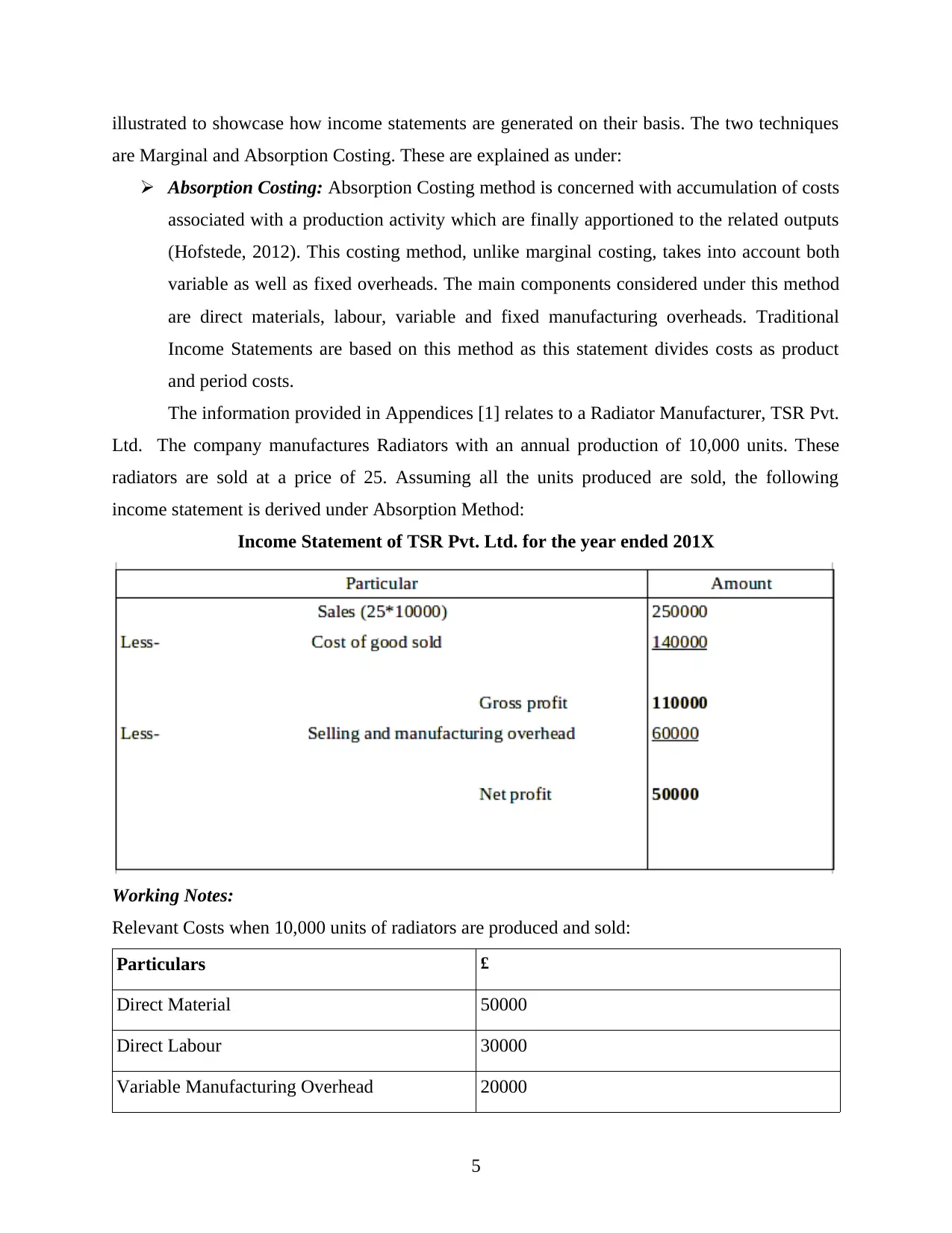
illustrated to showcase how income statements are generated on their basis. The two techniques
are Marginal and Absorption Costing. These are explained as under:
Absorption Costing: Absorption Costing method is concerned with accumulation of costs
associated with a production activity which are finally apportioned to the related outputs
(Hofstede, 2012). This costing method, unlike marginal costing, takes into account both
variable as well as fixed overheads. The main components considered under this method
are direct materials, labour, variable and fixed manufacturing overheads. Traditional
Income Statements are based on this method as this statement divides costs as product
and period costs.
The information provided in Appendices [1] relates to a Radiator Manufacturer, TSR Pvt.
Ltd. The company manufactures Radiators with an annual production of 10,000 units. These
radiators are sold at a price of 25. Assuming all the units produced are sold, the following
income statement is derived under Absorption Method:
Income Statement of TSR Pvt. Ltd. for the year ended 201X
Working Notes:
Relevant Costs when 10,000 units of radiators are produced and sold:
Particulars £
Direct Material 50000
Direct Labour 30000
Variable Manufacturing Overhead 20000
5
are Marginal and Absorption Costing. These are explained as under:
Absorption Costing: Absorption Costing method is concerned with accumulation of costs
associated with a production activity which are finally apportioned to the related outputs
(Hofstede, 2012). This costing method, unlike marginal costing, takes into account both
variable as well as fixed overheads. The main components considered under this method
are direct materials, labour, variable and fixed manufacturing overheads. Traditional
Income Statements are based on this method as this statement divides costs as product
and period costs.
The information provided in Appendices [1] relates to a Radiator Manufacturer, TSR Pvt.
Ltd. The company manufactures Radiators with an annual production of 10,000 units. These
radiators are sold at a price of 25. Assuming all the units produced are sold, the following
income statement is derived under Absorption Method:
Income Statement of TSR Pvt. Ltd. for the year ended 201X
Working Notes:
Relevant Costs when 10,000 units of radiators are produced and sold:
Particulars £
Direct Material 50000
Direct Labour 30000
Variable Manufacturing Overhead 20000
5
Paraphrase This Document
Need a fresh take? Get an instant paraphrase of this document with our AI Paraphraser

Fixed Manufacturing Overhead 40000
Cost of Goods Sold 140000
Particulars £
Variable Manufacturing Overhead 20000
Fixed Manufacturing Overhead 40000
Selling and Manufacturing Expenses 60000
If the company decides to sell only 5,000 units out of total units of radiators produced,
the following affect will be seen in the income statement of TSR Pvt. Ltd. under this technique:
Income Statement of TSR Pvt. Ltd. for the year ended 201X
6
Cost of Goods Sold 140000
Particulars £
Variable Manufacturing Overhead 20000
Fixed Manufacturing Overhead 40000
Selling and Manufacturing Expenses 60000
If the company decides to sell only 5,000 units out of total units of radiators produced,
the following affect will be seen in the income statement of TSR Pvt. Ltd. under this technique:
Income Statement of TSR Pvt. Ltd. for the year ended 201X
6
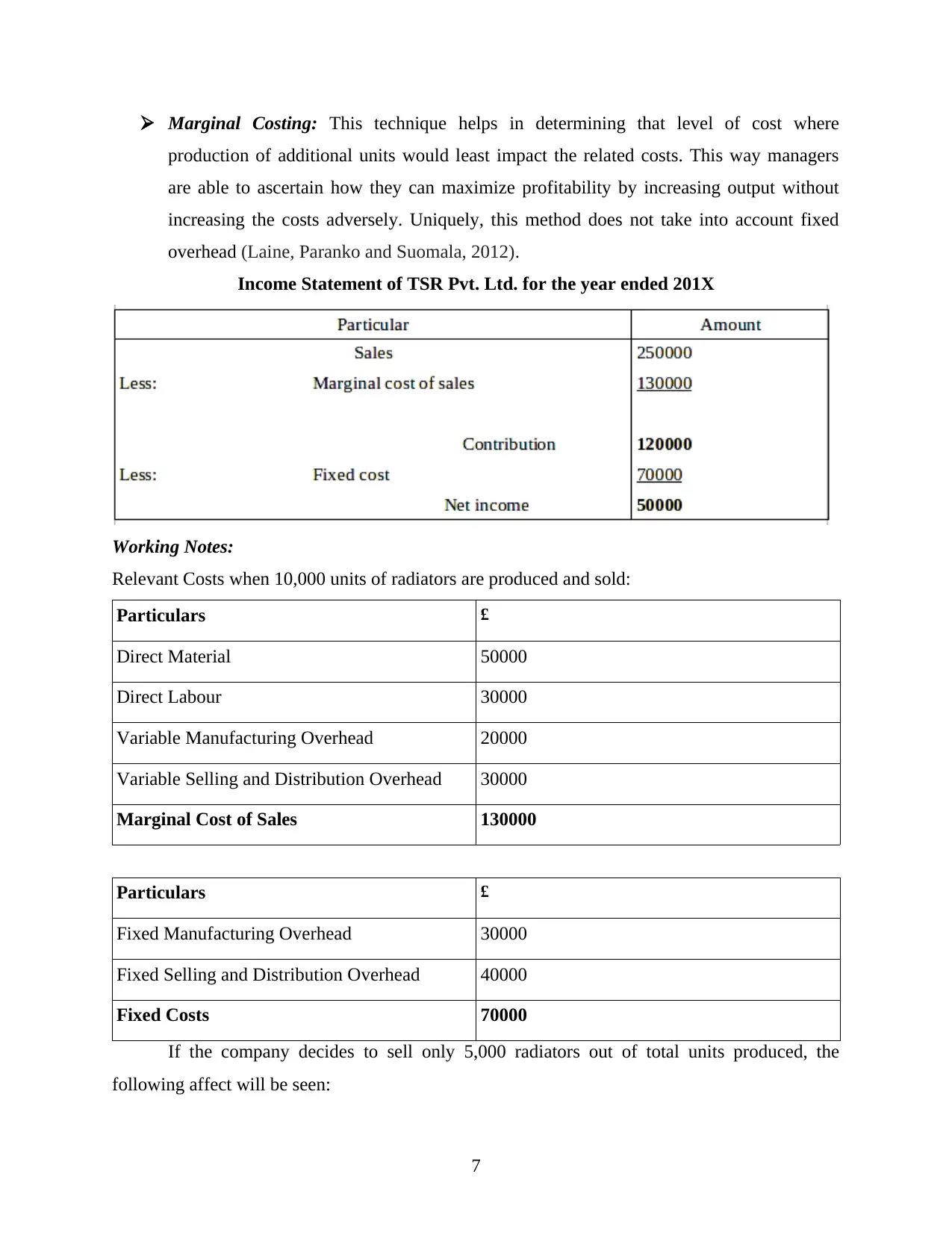
Marginal Costing: This technique helps in determining that level of cost where
production of additional units would least impact the related costs. This way managers
are able to ascertain how they can maximize profitability by increasing output without
increasing the costs adversely. Uniquely, this method does not take into account fixed
overhead (Laine, Paranko and Suomala, 2012).
Income Statement of TSR Pvt. Ltd. for the year ended 201X
Working Notes:
Relevant Costs when 10,000 units of radiators are produced and sold:
Particulars £
Direct Material 50000
Direct Labour 30000
Variable Manufacturing Overhead 20000
Variable Selling and Distribution Overhead 30000
Marginal Cost of Sales 130000
Particulars £
Fixed Manufacturing Overhead 30000
Fixed Selling and Distribution Overhead 40000
Fixed Costs 70000
If the company decides to sell only 5,000 radiators out of total units produced, the
following affect will be seen:
7
production of additional units would least impact the related costs. This way managers
are able to ascertain how they can maximize profitability by increasing output without
increasing the costs adversely. Uniquely, this method does not take into account fixed
overhead (Laine, Paranko and Suomala, 2012).
Income Statement of TSR Pvt. Ltd. for the year ended 201X
Working Notes:
Relevant Costs when 10,000 units of radiators are produced and sold:
Particulars £
Direct Material 50000
Direct Labour 30000
Variable Manufacturing Overhead 20000
Variable Selling and Distribution Overhead 30000
Marginal Cost of Sales 130000
Particulars £
Fixed Manufacturing Overhead 30000
Fixed Selling and Distribution Overhead 40000
Fixed Costs 70000
If the company decides to sell only 5,000 radiators out of total units produced, the
following affect will be seen:
7
⊘ This is a preview!⊘
Do you want full access?
Subscribe today to unlock all pages.

Trusted by 1+ million students worldwide
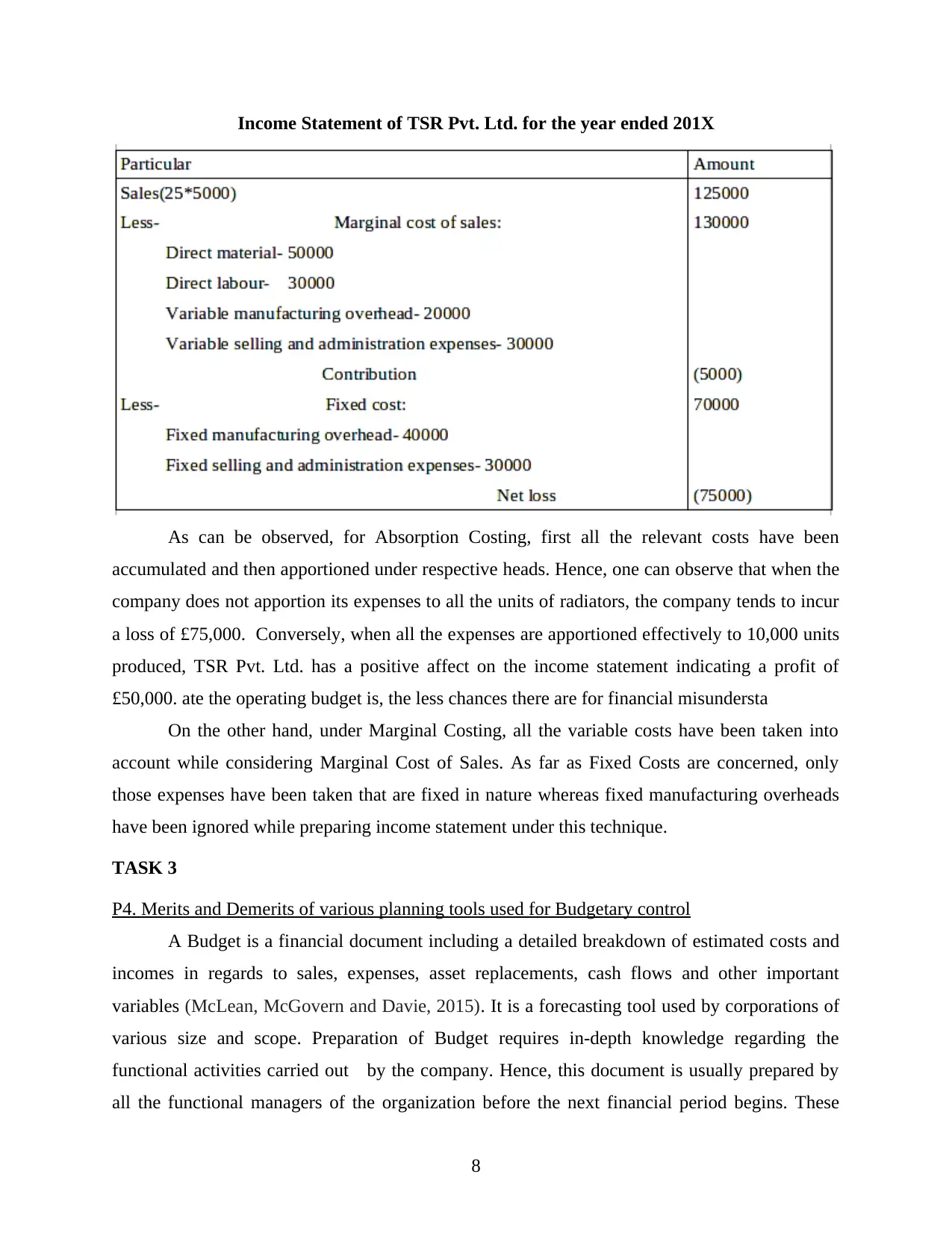
Income Statement of TSR Pvt. Ltd. for the year ended 201X
As can be observed, for Absorption Costing, first all the relevant costs have been
accumulated and then apportioned under respective heads. Hence, one can observe that when the
company does not apportion its expenses to all the units of radiators, the company tends to incur
a loss of £75,000. Conversely, when all the expenses are apportioned effectively to 10,000 units
produced, TSR Pvt. Ltd. has a positive affect on the income statement indicating a profit of
£50,000. ate the operating budget is, the less chances there are for financial misundersta
On the other hand, under Marginal Costing, all the variable costs have been taken into
account while considering Marginal Cost of Sales. As far as Fixed Costs are concerned, only
those expenses have been taken that are fixed in nature whereas fixed manufacturing overheads
have been ignored while preparing income statement under this technique.
TASK 3
P4. Merits and Demerits of various planning tools used for Budgetary control
A Budget is a financial document including a detailed breakdown of estimated costs and
incomes in regards to sales, expenses, asset replacements, cash flows and other important
variables (McLean, McGovern and Davie, 2015). It is a forecasting tool used by corporations of
various size and scope. Preparation of Budget requires in-depth knowledge regarding the
functional activities carried out by the company. Hence, this document is usually prepared by
all the functional managers of the organization before the next financial period begins. These
8
As can be observed, for Absorption Costing, first all the relevant costs have been
accumulated and then apportioned under respective heads. Hence, one can observe that when the
company does not apportion its expenses to all the units of radiators, the company tends to incur
a loss of £75,000. Conversely, when all the expenses are apportioned effectively to 10,000 units
produced, TSR Pvt. Ltd. has a positive affect on the income statement indicating a profit of
£50,000. ate the operating budget is, the less chances there are for financial misundersta
On the other hand, under Marginal Costing, all the variable costs have been taken into
account while considering Marginal Cost of Sales. As far as Fixed Costs are concerned, only
those expenses have been taken that are fixed in nature whereas fixed manufacturing overheads
have been ignored while preparing income statement under this technique.
TASK 3
P4. Merits and Demerits of various planning tools used for Budgetary control
A Budget is a financial document including a detailed breakdown of estimated costs and
incomes in regards to sales, expenses, asset replacements, cash flows and other important
variables (McLean, McGovern and Davie, 2015). It is a forecasting tool used by corporations of
various size and scope. Preparation of Budget requires in-depth knowledge regarding the
functional activities carried out by the company. Hence, this document is usually prepared by
all the functional managers of the organization before the next financial period begins. These
8
Paraphrase This Document
Need a fresh take? Get an instant paraphrase of this document with our AI Paraphraser
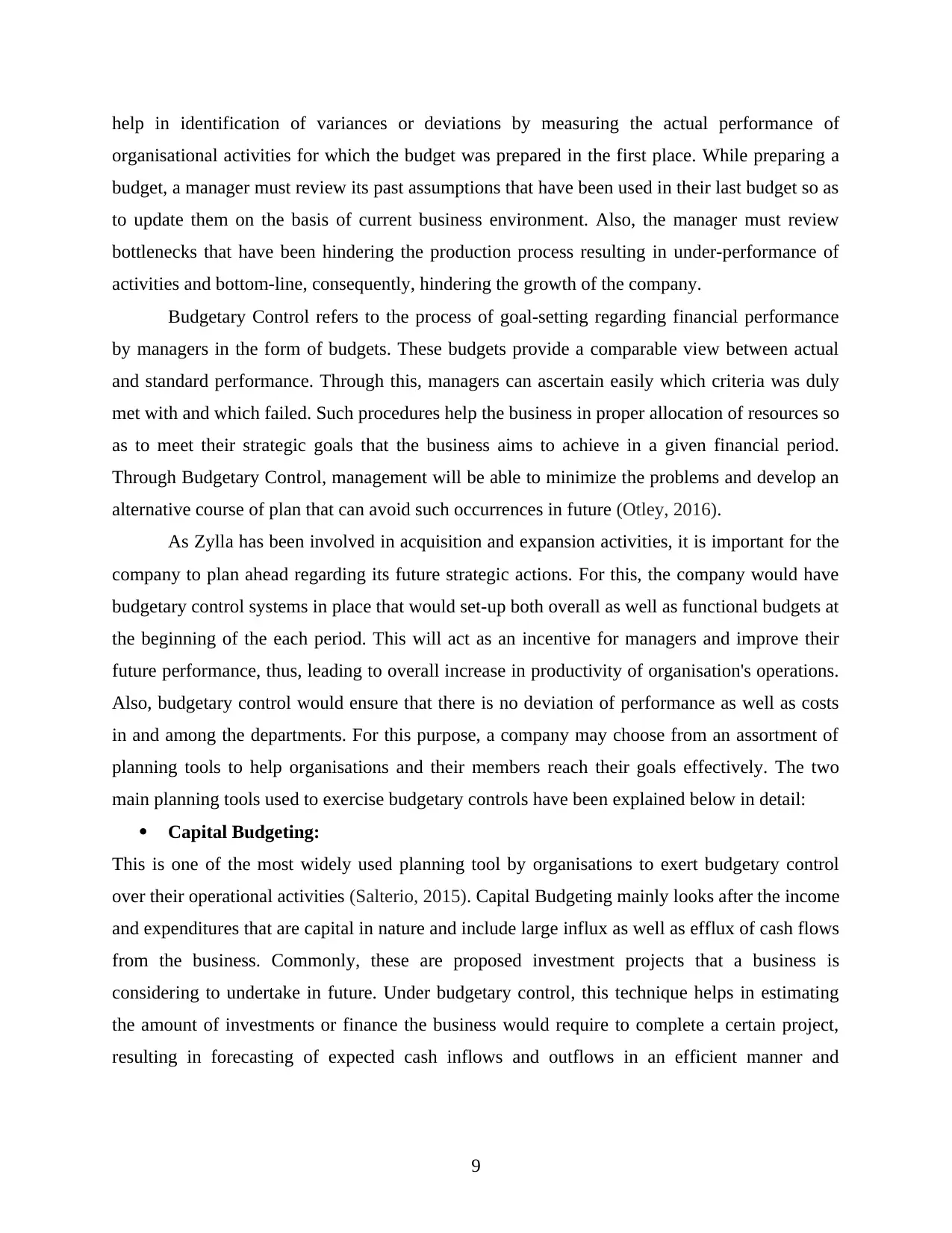
help in identification of variances or deviations by measuring the actual performance of
organisational activities for which the budget was prepared in the first place. While preparing a
budget, a manager must review its past assumptions that have been used in their last budget so as
to update them on the basis of current business environment. Also, the manager must review
bottlenecks that have been hindering the production process resulting in under-performance of
activities and bottom-line, consequently, hindering the growth of the company.
Budgetary Control refers to the process of goal-setting regarding financial performance
by managers in the form of budgets. These budgets provide a comparable view between actual
and standard performance. Through this, managers can ascertain easily which criteria was duly
met with and which failed. Such procedures help the business in proper allocation of resources so
as to meet their strategic goals that the business aims to achieve in a given financial period.
Through Budgetary Control, management will be able to minimize the problems and develop an
alternative course of plan that can avoid such occurrences in future (Otley, 2016).
As Zylla has been involved in acquisition and expansion activities, it is important for the
company to plan ahead regarding its future strategic actions. For this, the company would have
budgetary control systems in place that would set-up both overall as well as functional budgets at
the beginning of the each period. This will act as an incentive for managers and improve their
future performance, thus, leading to overall increase in productivity of organisation's operations.
Also, budgetary control would ensure that there is no deviation of performance as well as costs
in and among the departments. For this purpose, a company may choose from an assortment of
planning tools to help organisations and their members reach their goals effectively. The two
main planning tools used to exercise budgetary controls have been explained below in detail:
Capital Budgeting:
This is one of the most widely used planning tool by organisations to exert budgetary control
over their operational activities (Salterio, 2015). Capital Budgeting mainly looks after the income
and expenditures that are capital in nature and include large influx as well as efflux of cash flows
from the business. Commonly, these are proposed investment projects that a business is
considering to undertake in future. Under budgetary control, this technique helps in estimating
the amount of investments or finance the business would require to complete a certain project,
resulting in forecasting of expected cash inflows and outflows in an efficient manner and
9
organisational activities for which the budget was prepared in the first place. While preparing a
budget, a manager must review its past assumptions that have been used in their last budget so as
to update them on the basis of current business environment. Also, the manager must review
bottlenecks that have been hindering the production process resulting in under-performance of
activities and bottom-line, consequently, hindering the growth of the company.
Budgetary Control refers to the process of goal-setting regarding financial performance
by managers in the form of budgets. These budgets provide a comparable view between actual
and standard performance. Through this, managers can ascertain easily which criteria was duly
met with and which failed. Such procedures help the business in proper allocation of resources so
as to meet their strategic goals that the business aims to achieve in a given financial period.
Through Budgetary Control, management will be able to minimize the problems and develop an
alternative course of plan that can avoid such occurrences in future (Otley, 2016).
As Zylla has been involved in acquisition and expansion activities, it is important for the
company to plan ahead regarding its future strategic actions. For this, the company would have
budgetary control systems in place that would set-up both overall as well as functional budgets at
the beginning of the each period. This will act as an incentive for managers and improve their
future performance, thus, leading to overall increase in productivity of organisation's operations.
Also, budgetary control would ensure that there is no deviation of performance as well as costs
in and among the departments. For this purpose, a company may choose from an assortment of
planning tools to help organisations and their members reach their goals effectively. The two
main planning tools used to exercise budgetary controls have been explained below in detail:
Capital Budgeting:
This is one of the most widely used planning tool by organisations to exert budgetary control
over their operational activities (Salterio, 2015). Capital Budgeting mainly looks after the income
and expenditures that are capital in nature and include large influx as well as efflux of cash flows
from the business. Commonly, these are proposed investment projects that a business is
considering to undertake in future. Under budgetary control, this technique helps in estimating
the amount of investments or finance the business would require to complete a certain project,
resulting in forecasting of expected cash inflows and outflows in an efficient manner and
9
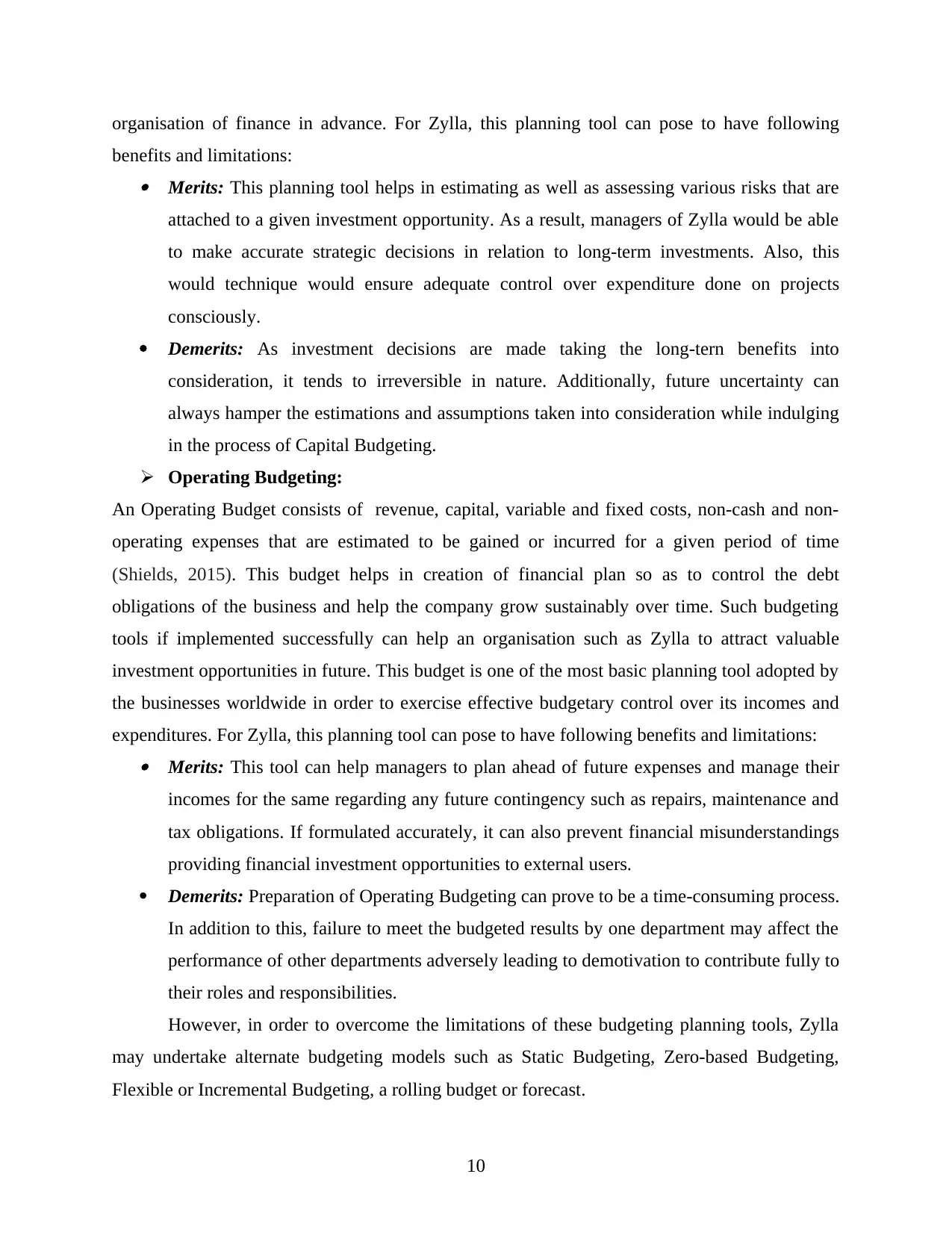
organisation of finance in advance. For Zylla, this planning tool can pose to have following
benefits and limitations: Merits: This planning tool helps in estimating as well as assessing various risks that are
attached to a given investment opportunity. As a result, managers of Zylla would be able
to make accurate strategic decisions in relation to long-term investments. Also, this
would technique would ensure adequate control over expenditure done on projects
consciously.
Demerits: As investment decisions are made taking the long-tern benefits into
consideration, it tends to irreversible in nature. Additionally, future uncertainty can
always hamper the estimations and assumptions taken into consideration while indulging
in the process of Capital Budgeting.
Operating Budgeting:
An Operating Budget consists of revenue, capital, variable and fixed costs, non-cash and non-
operating expenses that are estimated to be gained or incurred for a given period of time
(Shields, 2015). This budget helps in creation of financial plan so as to control the debt
obligations of the business and help the company grow sustainably over time. Such budgeting
tools if implemented successfully can help an organisation such as Zylla to attract valuable
investment opportunities in future. This budget is one of the most basic planning tool adopted by
the businesses worldwide in order to exercise effective budgetary control over its incomes and
expenditures. For Zylla, this planning tool can pose to have following benefits and limitations: Merits: This tool can help managers to plan ahead of future expenses and manage their
incomes for the same regarding any future contingency such as repairs, maintenance and
tax obligations. If formulated accurately, it can also prevent financial misunderstandings
providing financial investment opportunities to external users.
Demerits: Preparation of Operating Budgeting can prove to be a time-consuming process.
In addition to this, failure to meet the budgeted results by one department may affect the
performance of other departments adversely leading to demotivation to contribute fully to
their roles and responsibilities.
However, in order to overcome the limitations of these budgeting planning tools, Zylla
may undertake alternate budgeting models such as Static Budgeting, Zero-based Budgeting,
Flexible or Incremental Budgeting, a rolling budget or forecast.
10
benefits and limitations: Merits: This planning tool helps in estimating as well as assessing various risks that are
attached to a given investment opportunity. As a result, managers of Zylla would be able
to make accurate strategic decisions in relation to long-term investments. Also, this
would technique would ensure adequate control over expenditure done on projects
consciously.
Demerits: As investment decisions are made taking the long-tern benefits into
consideration, it tends to irreversible in nature. Additionally, future uncertainty can
always hamper the estimations and assumptions taken into consideration while indulging
in the process of Capital Budgeting.
Operating Budgeting:
An Operating Budget consists of revenue, capital, variable and fixed costs, non-cash and non-
operating expenses that are estimated to be gained or incurred for a given period of time
(Shields, 2015). This budget helps in creation of financial plan so as to control the debt
obligations of the business and help the company grow sustainably over time. Such budgeting
tools if implemented successfully can help an organisation such as Zylla to attract valuable
investment opportunities in future. This budget is one of the most basic planning tool adopted by
the businesses worldwide in order to exercise effective budgetary control over its incomes and
expenditures. For Zylla, this planning tool can pose to have following benefits and limitations: Merits: This tool can help managers to plan ahead of future expenses and manage their
incomes for the same regarding any future contingency such as repairs, maintenance and
tax obligations. If formulated accurately, it can also prevent financial misunderstandings
providing financial investment opportunities to external users.
Demerits: Preparation of Operating Budgeting can prove to be a time-consuming process.
In addition to this, failure to meet the budgeted results by one department may affect the
performance of other departments adversely leading to demotivation to contribute fully to
their roles and responsibilities.
However, in order to overcome the limitations of these budgeting planning tools, Zylla
may undertake alternate budgeting models such as Static Budgeting, Zero-based Budgeting,
Flexible or Incremental Budgeting, a rolling budget or forecast.
10
⊘ This is a preview!⊘
Do you want full access?
Subscribe today to unlock all pages.

Trusted by 1+ million students worldwide
1 out of 17
Related Documents
Your All-in-One AI-Powered Toolkit for Academic Success.
+13062052269
info@desklib.com
Available 24*7 on WhatsApp / Email
![[object Object]](/_next/static/media/star-bottom.7253800d.svg)
Unlock your academic potential
Copyright © 2020–2025 A2Z Services. All Rights Reserved. Developed and managed by ZUCOL.





